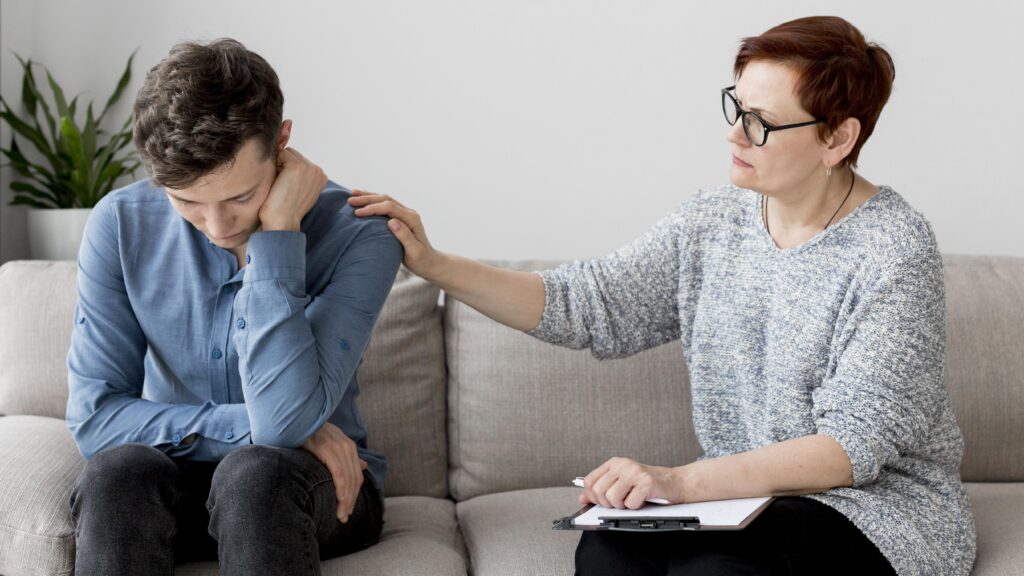Thanks for coming to Better Lives Building Tribes. The things we want to do are help people improve their minds. There are different kinds of therapy for anxiety. This blog post talks about how therapy can change people’s lives and help they deal with sadness and anxiety. Read about these diseases and the way to treat them before you overcome dry and unhealthy lives.
What Is a Common Therapy Used to Treat Anxiety and Depression?
The most common mental illness is to become stressed or sad. They happen together a lot and make everyday life very different. Good news: both diseases have medicines that have been shown to work.
One of the best and most famous ways is cognitive behavioral therapy or CBT.
How CBT Works for Anxiety and Depression
Identifying Negative Thought Patterns: CBT helps people see the wrong way of thinking that makes them sad and anxious.
Reframing Thoughts: The therapy is making people change negative thoughts into good and healthy thoughts.
Behavioral Strategies: However, CBT is based on steps you can take—people who suffer from anxiety can get help from exposure therapy, for example, or people struggling with depression can be encouraged to think of things to do—to help people learn how to make changes that will last.
CBT works, many studies have shown and that is one of the reasons why people with anxiety and depression are commonly treated this way. It is usually offered one-to-one or in groups and can be modified to suit your needs.
Other common therapies include:
- Dialectical Behavioral Therapy (DBT): Good to control strong feelings.
- Interpersonal Therapy (IPT): It was about easing the symptoms by improving the relationships.
- Mindfulness-Based Cognitive Therapy (MBCT): It is mindfulness practice combined with traditional CBT.
What Are the Different Types of Anxiety Therapy?
Therapy doesn’t work the same way for everyone who has worry. Every type and amount of anxiety is different, and each type of therapy can help. These are the best ways to finish what you need to do:
Cognitive Behavioral Therapy (CBT):
- was thought to be the best way to calm down.
- tries to figure out and change the thoughts that keep fear and worry going.
- As an example, exposure treatment puts people in a safe place to face their fears.
Exposure Therapy:
- Many people who have fears, social anxiety, or PTSD find this type of therapy, which is a subset of CBT, very helpful.
- Time spent growing accustomed to things or events that scare you are less likely to take flight and more confident that you can handle them.
Acceptance and Commitment Therapy (ACT):
- tells people to not try to hide how they feel but to accept them.
- It helps people make sure that what they do is in line with their ideals, which makes everyday life less stressful.
Eye Movement Desensitization and Reprocessing (EMDR):
- Often used for stress-related worry, like PTSD.
- Guided eye movements and mental recall are used together to help people deal with traumatic events again.
Mindfulness-Based Therapies:
- includes things like body scanning and meditation that can help people stay present.
- Lessens the cycles of negative thoughts that are common in people with sadness and anxiety.
Psychodynamic Therapy:
- looks at unconscious patterns and past events that have led to present anxiety.
- focuses on understanding yourself and your feelings.
Benefits of each anxiety therapy type can vary and they all can be changed as desired ensuring complete healing.
What Role Does Therapy Play in Treating Anxiety?
Important part of mental health care, therapy provides people with anxiety that tools, support and methods to be able to work problems. Here are some ways that treatment can change things:
Providing a Safe Space:
- It’s safe to talk about your worries and fears in there.
- Being able to share freely might help ease those that suffer from anxiety that often feel alone.
Identifying Triggers:
- A therapist can help people get to the bottom of what thoughts, feelings or patterns cause anxiety.
- The first thing you need to know in order to deal with this triggers successfully is knowing these triggers.
Building Coping Mechanisms:
- We learn in therapy useful ways to cope with stress, anxiety, and the like.
- Many of us are taught things like progressive muscle relaxation, mindfulness, breathing exercises.
Fostering Resilience:
- Depending on how long you are subject to therapy for, this can actually make you stronger emotionally when the time comes, thus making it easier to solve current problems in the future.
- Dealing with the causes of your anxiety lets people recognize who you are.
Helping Enabled Behavioral Changes:
- Cognitive behavioral therapy (CBT) and other therapies attempt to reform bad habits and the way we think.
- As a result, people are less likely to avoid situations and bad situations, are better to deal with people and feel much more confident.
Complementing Medication:
- Help can be given in the way of medication, but treatment is treating the problem at its source (root), rather than simply treating the symptoms of the problem.
- Combination of treatment sometimes work best for people with severe anxiety and sadness.
Not only does treatment help with the feeling of being overwhelmed by anxiety but also wins for their whole mental health by offering the proper tools and helping them live fuller lives.
Conclusion
Anxiety and sadness are complicated conditions, but there is hope and healing through effective treatments. With CBT, exposure therapy, or mindfulness-based practices, anxiety treatment gives people the tools they need to deal with the problems they face in life.
We at Better Lives Building Tribes think that the first step to taking back your mental health is to know what your choices are. While therapy makes people feel better who have anxiety, it also has the effect of making people more self aware, stronger, and better over time.
If that sounds like you (or someone you care about), you might book an appointment with a mental health professional about the best way to help. Remember, this never happens overnight. The first step is a step in the right direction to a healthier future.


